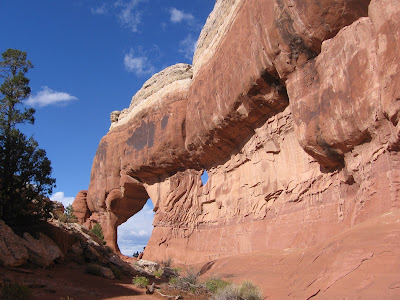The Cameo Cliffs is a special BLM management area 30 miles south of Moab and 18 miles north of Monticello in southeast Utah. The area has about 50 miles of trails usable by ATVs and others on 15 well marked routes. These trails are mostly old mining and ranching routes and pass through a very scenic area of sandstone cliffs, canyons, and rounded domes.
I started at the Hook and Ladder staging area, an east turn on Steen Road off of Highway 191. There is also a sign at the turnoff saying OHV Trailhead. There are good maps of the area available at the trailhead published by the San Juan Public Entry and Access Rights (SPEAR) organization. From the trailhead area, Trail 1 starts to the east and reaches a junction with Trail 2 after about 15 minutes of hiking.
I stayed on Trail 1 as it turned north toward the Cameo Cliffs. The trails I walked on are slightly sandy narrow roads. It took me 0:50 minutes of hiking to get to the Junction with Trail 3 that circles around the south and west side of the Cameo Cliffs.
The south side of the cliffs has a large cove that Trail 3 circles into and around. The habitat here is scattered Utah Juniper and Pinon Pines with grasses and sagebrush, Mormon Tea, Prickly Pear cactus and other desert shrubs.
On the west side of the Cameo Cliffs there is another cove area. Along the cliff face there are several alcoves that look like arches are forming. A short distance north of the cove area there is a large alcove where an arch has formed. I think this one is known as One Eye Window.
It took me 2:25 hours of hiking to arrive at the One Eye Window. There is another old road that is not part of the marked trail system visible to the west near the arch that would allow an alternate return route for a hiker. I decided to continue north to the next trail junction with Trail 9 and complete the loop around the Cameo Cliffs.
The Trail 9 segment is 2 miles east and west along an area called the Cameo Terrace. The views here are north across a very scenic valley of sandstone outcrops with the LaSal Mountains in the distance. I saw a very large monolith fin near the base of the cliffs in the distance. This spectacular area is also part of the trail system. The map shows routes going to the top of the distant cliffs and on to a view point of the roadside Wilson Arch.
Trail 9 makes a junction with Trail 1 that leads back to the Hook and Ladder Trailhead in 3 miles. My total hike took 4:50 hours for about 10 miles. I hiked on a very mild 54 F degree mid December day. On the day I hiked, I didn’t see any other visitors to the area.











































